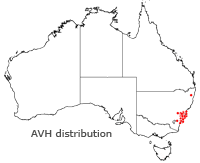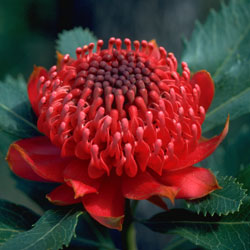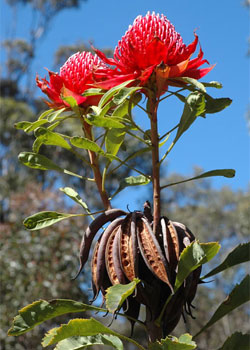Telopea speciosissima
NSW Waratah
Telopea speciosissima (Sm.) R.Br.
 Telopea speciosissima , commonly known as the New South Wales Waratah, is a member of the family Proteaceae. It is restricted to an area within about 200 km of Sydney. T. speciosissima flowers over a six-week period in spring (September-October) in the Sydney region, but later in cooler areas.
Telopea speciosissima , commonly known as the New South Wales Waratah, is a member of the family Proteaceae. It is restricted to an area within about 200 km of Sydney. T. speciosissima flowers over a six-week period in spring (September-October) in the Sydney region, but later in cooler areas.
The whole plant is a large, long-lived shrub that generally grows to about 3 m tall. The T. speciosissima flower head is an inflorescence comprising of anywhere between 10 and 240 individual flowers. The size and shape of the blooms of the Waratah can vary considerably, as can the range of naturally occurring colours, although the majority are red and pink. The leaves are oblong, evenly toothed and dark green in colour.
Telopea speciosissima is an ideal cut flower, being long lasting with flowers occurring terminally on long straight stems. The species is widely cultivated for the cut flower market both in Australia and overseas. Despite this the plant has not proven easy to cultivate under normal garden conditions.
Telopea speciosissima can be grown from cuttings but the easiest way to propagate it is from seed . Fresh seed has a high viability and germinates 2-3 weeks after sowing. Seedling plants take about five years to flower, while cuttings may take only two years. Plants should be planted out as soon as they are large enough to handle (about 15cm).
Telopea speciosissima prefers partial shade and plants will not thrive in heavily shaded areas or in direct sunlight. Fertilising with a slow release, low-phosphorus fertiliser after flowering is beneficial. Flowers can be cut for indoor decoration or can be removed from the plant after flowering has finished by cutting the canes back to at least half of their length.
Waratahs need regular watering. T. speciosissima should be planted in an area with good drainage. The roots should never be allowed to dry out, however they should not remain too wet. Cultivated Waratahs require heavy pruning once established; about 3/4 of the plant should be removed immediately after flowering. Waratahs have a lignotuber which contains numerous dormant buds and allows the plant to continue to grow after heavy pruning.
Bract browning is a condition that can affect the quality of Waratah flowers. It occurs prior to harvest and affects the showy floral bracts surrounding the inflorescence. Research into the causes of bract browning have shown that the problem is caused by sun exposure and can be reduced by protecting plants with 50% shade cloth, which reduces light damage and destruction of pigment in the bracts.
Text by Jen Taylor (2011 Student Botanical Intern)
Name Meaning: Telopea speciosissimaTelopea – from the Greek telopos, meaning ‘seen from afar’ a reference to the conspicuous flowers speciosissima – from the Latin speciosus, ‘showy’ and issimus, ‘most’ |
References
McConchie, R., Martyn, A. & Offord, C. (2005) Effect of Shade on Bract Browning of Waratahs (Telopea spp.). Acta Horticulturae, 694:439-443. Available at http ://www.actahort.org/books/694/694_72.htm.
Offord, C. (2004) An Examination of the Reproductive Biology of Telopea speciosissima (Proteaceae) with Emphasis on the Nature of Protandry and the Role of Self ‐ Pollination in Fruit Set. International Journal of Plant Sciences, 165(1): 73-83.
Armstrong, J.A. (1987) Waratahs, their biology, cultivation and conservation: based on a symposium conducted by the Australian Flora Foundation and held at the Australian Academy of Science Building, Canberra, ACT, October, 1984. Occasional publication (Australian National Botanic Gardens); no. 9. Australian Government Publishing Service.
Nixon, P. (1987) The Waratah. Kangaroo Press, Cornell University.
Boden, Anne (1985) Floral Emblem of NSW website: www.anbg.gov.au/emblems/nsw.emblem.html
![An Australian Government Initiative [logo]](/images/austgovt_brown_90px.gif)



